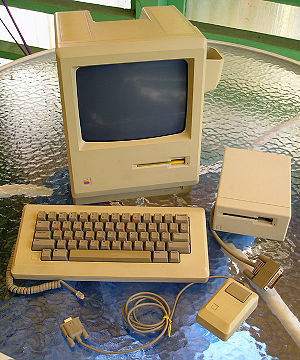Macintosh External Disk Drive
 |
|
| Developer | Apple Computer |
|---|---|
| Type | Disk Drive |
| Release date | May 4, 1984 |
| Introductory price | US$495 |
The Macintosh External Disk Drive is the original of a series of external 3.5" floppy disk drives manufactured and sold by Apple Computer exclusively for the Macintosh series of computers introduced in January 1984. Later, Apple would unify their external drives to work cross-platform between the Macintosh and Apple II product lines, dropping the name "Macintosh" from the drives. Though Apple had been producing external floppy disk drives prior to 1984, they were exclusively developed for the Apple II, III and Lisa computers using the industry standard 5.25" flexible disk format. The Macintosh external drives were the first to widely introduce Sony's new 3.5" rigid disk standard commercially and throughout their product line. Apple produced only one external 3.5" drive exclusively for use with the Apple II series called the Apple UniDisk 3.5.
The original Macintosh External Disk Drive (M0130) was introduced with the Macintosh on January 24, 1984. However, it did not actually ship until May 4, 1984, sixty days after Apple had promised it to dealers. Bill Fernandez was the project manager who oversaw the design and production of the drive. The drive case was designed to match the Macintosh and included the same 400K drive (a Sony-made 3.5" single-sided mechanism) installed inside the Macintosh. Although very similar to the 400K drive which newly replaced Apple's ill-fated Twiggy drive in the Lisa, there were subtle differences relating mainly to the eject mechanism. However, confusingly all of these drives were labelled identically. The Macintosh could only support one external drive, limiting the number of floppy disks mounted at once to two, but both Apple and third party manufacturers developed external hard drives that connected to the Mac's floppy disk port, which had pass-through ports to accommodate daisy-chaining the external disk drive. Apple's Hard Disk 20 could accommodate an additional daisy-chained hard drive as well as an external floppy disk.
3.5" single-sided floppies had been used on several microcomputers and synthesizers in the early 1980s, including the Hewlett Packard 150 and various MSX computers. The standard on all of these was MFM with 80 tracks and 9 sectors per track, giving 360k per disk. However, Apple's custom interface used GCR (Group Coded Recording) and a unique format which put fewer sectors on the smaller inner tracks and more sectors on the wider outer tracks of the disk. The disk would speed up when accessing the inner tracks and slow down when accessing the outer ones. This allowed more space per disk (400k) and also improved reliability by reducing the number of sectors on the inner tracks which had less physical media to allocate to each sector.
...
Wikipedia
